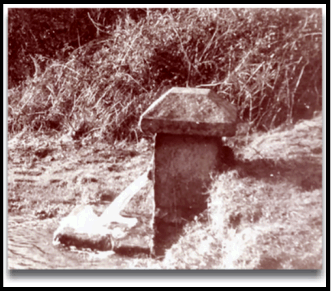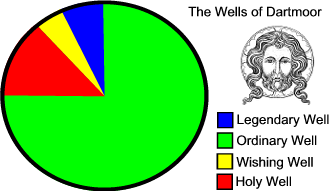The Lady Well is sat beside the old A30 at the western end of Sticklepath. The well is a small granite trough that is fed by a pipe, with a large lintel boulder over the top of the well. On this boulder is an inscription (which will be important later!). In 1927 Court implied that the presence of the well here is an indication that this road is “one of the most ancient tracks of men in the West”.
The source of the well is a spring that lies further up the opposite hillside in Allermead, this is where the original well was located. The well at Allermead had a constant trickle of water which fell into a pool about three inches in diameter and around four feet deep. The well was famed for never drying up and around 1820 a local woolstapler, John Pearse, had the overflow from the Allermead spring piped across the road to the current location of the Lady Well.
The water was collected in a tank under the granite rocks. Old photographs show that the current lintel stone is not the original. In 1887 the water from the Lady Well was piped down the main street in Sticklepath to various standpipes to celebrate Queen Victoria’s Jubilee. This meant that many residents no longer had to walk to the other end of the village to draw water, and an electric pump was installed in the well-house to carry water up to the village school again meaning people didn’t have to carry water. At one time the waste water from the well was used to flush the sewers on the north side of the village.
Unfortunately there appears to be no reference to which ‘lady’ the well takes its name from, or of any healing properties that the well may have been associated with. Despite a possible medieval origin the well seems to have been a purely functional water source.
Another notable piece of history is a rock-pile which has been painted white, just above the well on the steep hillside. This is said to have been the place where John Wesley used to preach. As Sticklepaths stands on what used to be the main route running through Devon into Cornwall, therefore John Wesley passed through on many occasions. Every year the White Roock has been given a new coat of whitewash to commemorate the visit of the preacher. This was usually done on an April Sunday and was carried out by local Wesleyans but since the 1950’s this has been carried out by members of the Men’s Club, and since then by the Sticklepath and Okehampton Conservation Group.

Now onto the multi:
A : How many lines of text are there on the lintel?
B : How many letters make up the first line?
C : How many words in total?
D : How many pipes protruding from the well?
E : How many stones form the semi-circular rim of the well?
The cache can be found at:
N 50 4A.(B-D)CA W003 5(C-D).ED(E-B)
This image from the Legendary Dartmoor website demonstrates all the Dartmoor wells and springs with the classifications of Ordinary, Holy, Wishing and Legendary.
 ;
;
I, LizMar2010, am hoping to get this new series up and running nationally. So if you decide to lay one or more with this series, please let me know via ancientwellsl@yahoo.com so that I can issue a number and I will add them in a bookmark